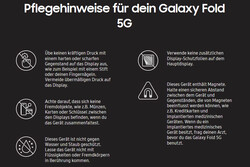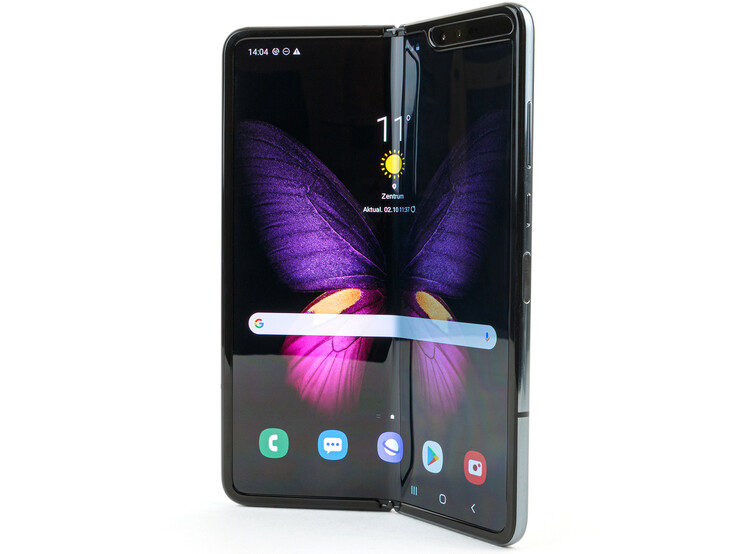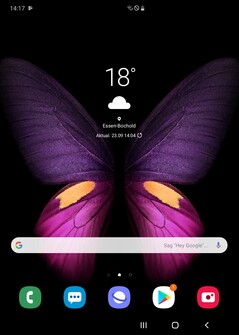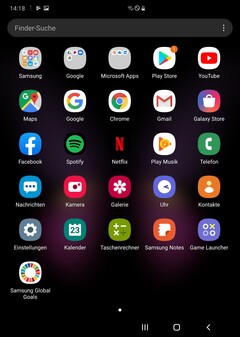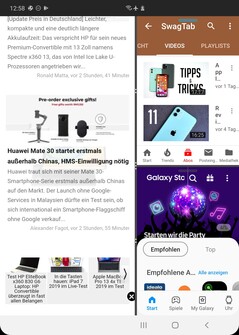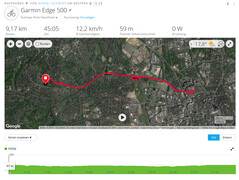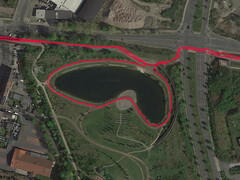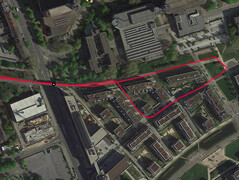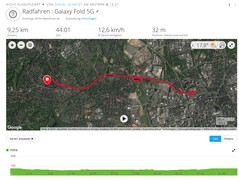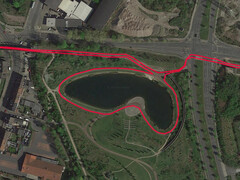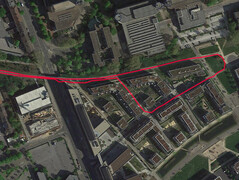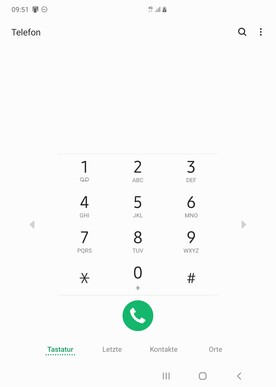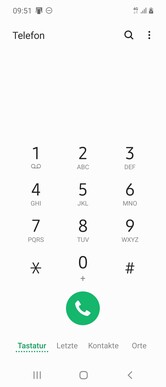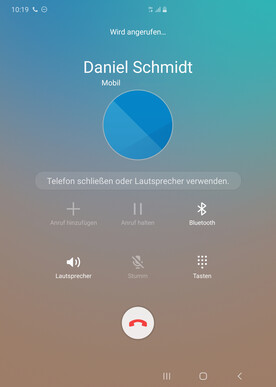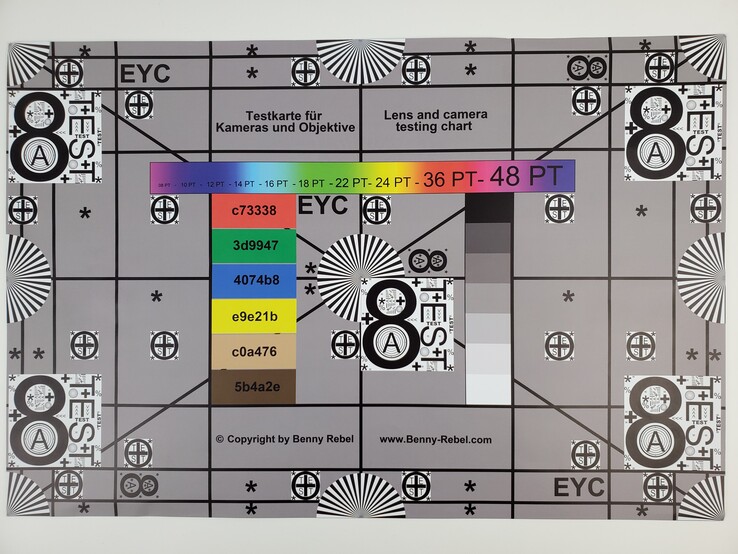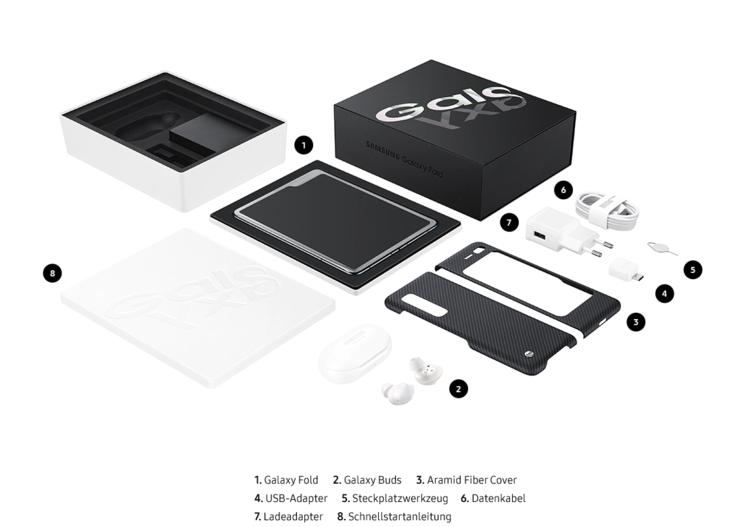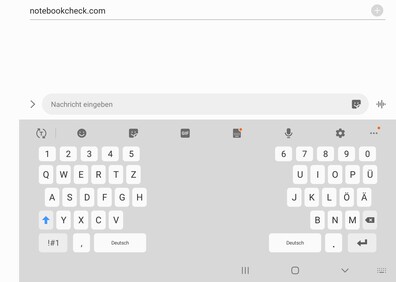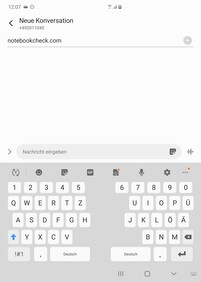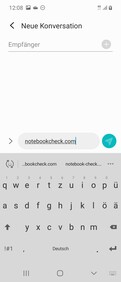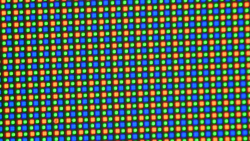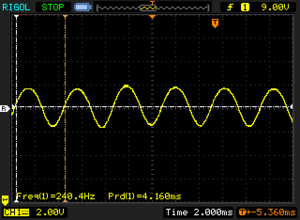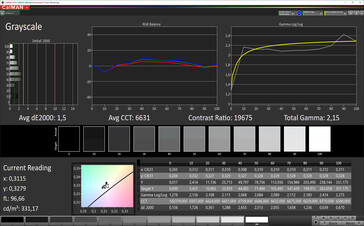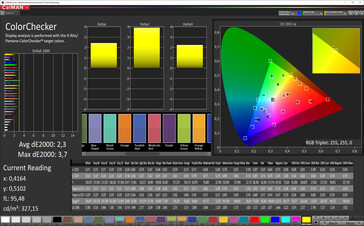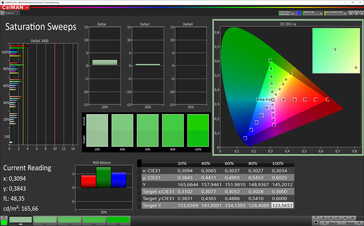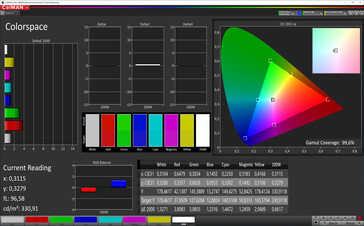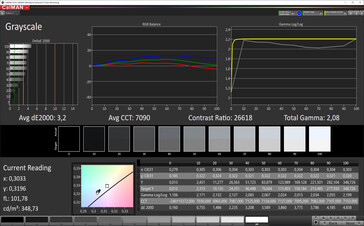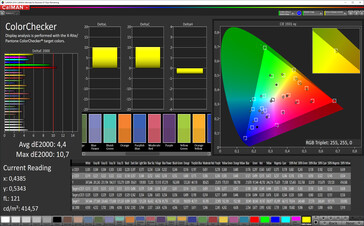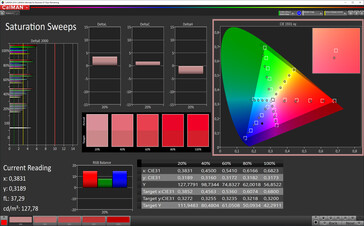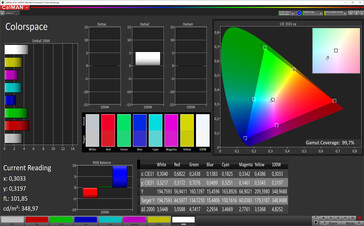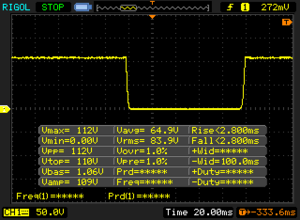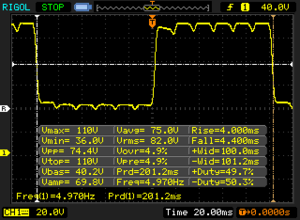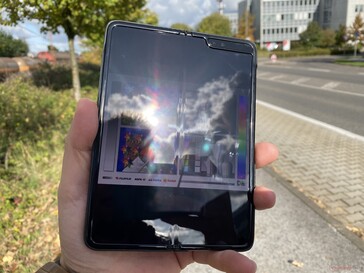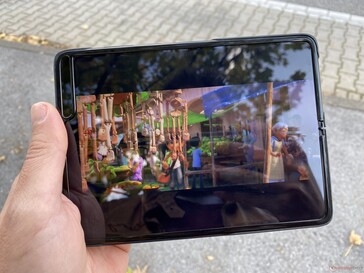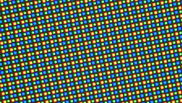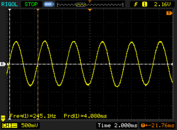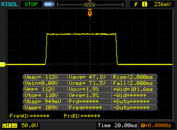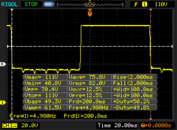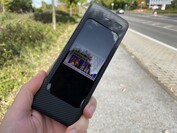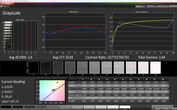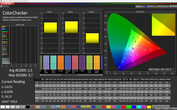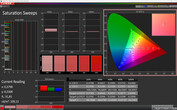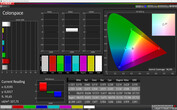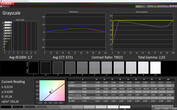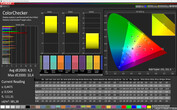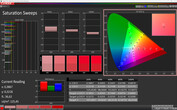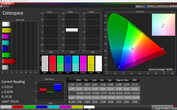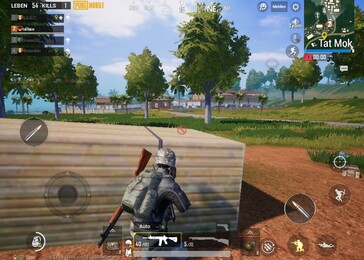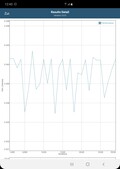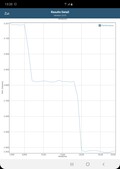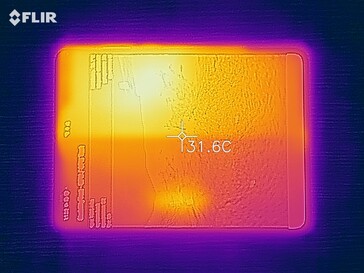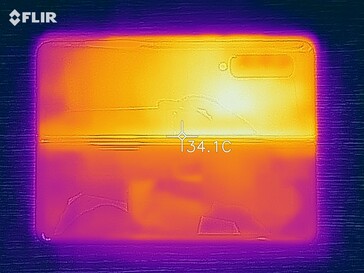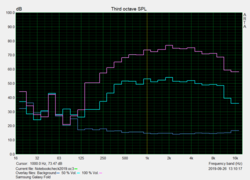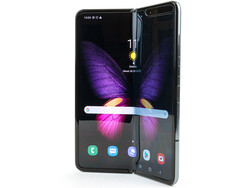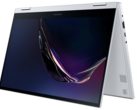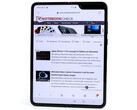Samsung Galaxy Fold 5G Smartphone Review: A foldable handset with an air of confidence
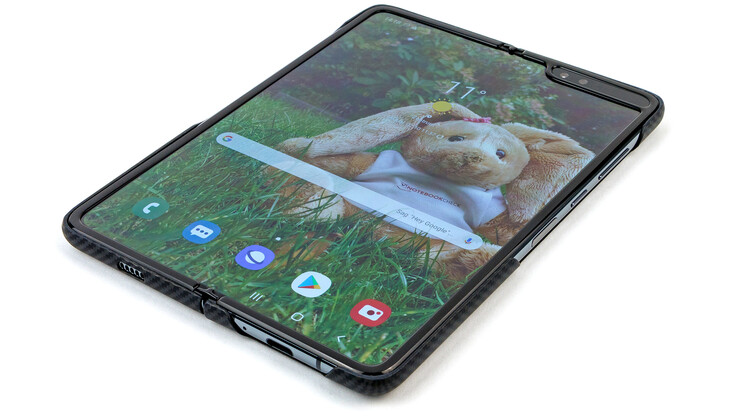
The Galaxy Fold is Samsung's first folding smartphone and the first to reach the market, at least in Europe. The company originally started the release schedule in spring, but hardware issues resulted in Samsung postponing the official launch. Now, the South Korean company has released a revised version of the Galaxy Fold for 2,100 Euros (~$2,304) in Germany. While Samsung sells 4G and 5G versions of the Galaxy Fold in some markets, only the 5G version is available in Europe.
While all other European variants of 5G Samsung handsets come with an Exynos chipset, the Galaxy Fold features a Qualcomm Snapdragon 855 that integrates a Qualcomm X50 modem. We should also point out that the 5G model has a slightly smaller battery than its 4G counterpart. The former has a 4,235 mAh capacity, while the 4G SKU has a 4,380 mAh capacity, for reference.
The focus of this review is the 7.3-inch foldable OLED display. Samsung has, as you may already know, included a smaller secondary display too, so you need not open the Galaxy Fold every time you want to use it. We shall, of course, see how practical this new concept and form factor is, along with whether it can withstand the rigours of our tests.
Device comparison
Rating | Date | Model | Weight | Drive | Size | Resolution | Price |
|---|---|---|---|---|---|---|---|
| 86.4 % v7 (old) | 10 / 2019 | Samsung Galaxy Fold SD 855, Adreno 640 | 276 g | 512 GB UFS 3.0 Flash | 7.30" | 2152x1536 | |
| 87.1 % v7 (old) | 09 / 2019 | Apple iPhone 11 Pro Max A13 Bionic, A13 Bionic GPU | 226 g | 64 GB SSD | 6.50" | 2688x1242 | |
| 84.5 % v7 (old) | 01 / 2019 | Huawei Mate 20 X Kirin 980, Mali-G76 MP10 | 232 g | 128 GB UFS 2.1 Flash | 7.20" | 2244x1080 | |
| 87.4 % v7 (old) | 07 / 2019 | Samsung Galaxy S10 5G Exynos 9820, Mali-G76 MP12 | 198 g | 256 GB UFS 2.1 Flash | 6.70" | 3040x1440 | |
| 85.1 % v7 (old) | 07 / 2019 | ZTE Axon 10 Pro SD 855, Adreno 640 | 178 g | 128 GB UFS 2.1 Flash | 6.47" | 2340x1080 |
Case - Glass, stainless steel and a sensitive plastic display
When folded, the Galaxy Fold fits nicely in our hands and measures 160.9 x 62.8 x 17.1 mm. The device looks stylish, especially because of its narrow and compact design. No-one should have any issues with slipping the Galaxy Fold into their trouser pocket, for example.
One of the issues that Samsung has revised is the protective film, which either started to peel up on early units or was mistaken for a removable screen protector. The protective film now wraps under the plastic frame rather than finishing at its edges as it did previously, hopefully making the Galaxy Fold more durable. Samsung also points out that no screen protector should be adhered atop of the protective film, as doing so could damage the device. The company has added small pieces of plastic around the upper and lower display edges too, which should make it harder for dust and other foreign objects to get under the screen.
The Galaxy Fold looks solid in the flesh and but for the reports about the device's fragility, we would take the same precautions using it as we do with any other smartphone. The Fold held up surprisingly well to being abused by JerryRigEverything, although he noted that fingernails can cause permanent damage to the foldable display. Samsung has published a care video making the same point too, stressing that care should be taken when using the touchscreen. The company has also published care instructions for using the Fold, which you can find here.
The Galaxy Fold has a glass exterior and a permanently installed battery, just like other high-end Samsung smartphones. The device has no IP or MIL-STD certifications though, making it vulnerable to the ingress of dust and liquids.
Connectivity - No surprises with the Galaxy Fold
The Fold shares most of its connectivity with the Galaxy S10 5G. Hence, Samsung has not included an IR blaster or a radio receiver, both of which some OEMs still include in their devices. The Galaxy Fold lacks a heart-rate sensor too, along with a headphone jack and a microSD card slot.
The USB 3.1 Gen1 Type-C port that Samsung has included can be used for charging and transmitting data and also outputting audio and video via HDMI or DisplayPort. You will need the appropriate adapter, with which you could also use DeX, Samsung's desktop replacement mode. The Type-C port supports USB Power Delivery (PD) too. Incidentally, the Fold offers ANT+, Bluetooth 5.0, MST and NFC.
Software - Better multitasking
The Galaxy Fold currently ships with One UI 1.5, an in-house customised version of Android 9.0 Pie. Samsung has adapted the OS specifically for foldable smartphones, with it being possible to display three apps simultaneously when the device is unfolded. You can also run the same app on both displays, but only those that have been adapted to do so. Currently, that only applies to a few Google and Samsung apps, though.
Unfortunately, our review unit comes with plenty of bloatware. Not only are there many Google and Samsung apps, but the Galaxy Fold has Microsoft, Facebook, Spotify and Netflix apps preinstalled too. While some people may find it useful to have these apps already on their phone when they first set it up, the inability to uninstall them is frustrating.
Samsung has not included any user account control either, so you cannot set up multiple profiles like you can on other Android smartphones. Our review unit had the August 1, 2019 set of Android security patches installed during our tests, which were relatively up to date. Samsung promises to furnish the Fold with regular updates for at least two years.
The Galaxy Fold supports not only 2G, 3G and 21 LTE bands, but also 5G. The device utilises LTE Cat. 18, which is great but it is something that we would have expected from a premium smartphone. Over 5G, the device can theoretically achieve 2.3 Gb/s downloads and 469 Mb/s uploads but only if the network to which you are connected supports those speeds. The device also only supports one 5G band in Europe, though.
Vodafone Germany kindly provided us with a 5G-enabled SIM card for our tests, but we did have to drive to find a 5G mast. While the data transfer speeds may not be that impressive on paper, websites appeared immediately with loading times in practice. We even encountered no loading or buffering times when streaming HD videos. Instead, it felt like we were watching offline content. However, the data rates of the transmitting mast were not all that impressive, yet.
The Galaxy Fold also supports the new Wi-Fi 6 standard. While the device can theoretically achieve up to 1.2 GB/s transfer speeds over Wi-Fi, it could not do so during our tests. Our Linksys EA8500 reference router proved a bottleneck here as it does not support Wi-Fi 6. It did certify that the Galaxy Fold can maintain stable Wi-Fi connections, though.
| Networking | |
| iperf3 transmit AX12 | |
| Huawei Mate 20 X | |
| Apple iPhone 11 Pro Max | |
| Samsung Galaxy Fold | |
| Samsung Galaxy S10 5G | |
| ZTE Axon 10 Pro | |
| iperf3 receive AX12 | |
| Samsung Galaxy Fold | |
| ZTE Axon 10 Pro | |
| Apple iPhone 11 Pro Max | |
| Samsung Galaxy S10 5G | |
| Huawei Mate 20 X | |
The Galaxy Fold uses BeiDou, Galileo, Glonass and GPS for location services. The device does not support SBAS or dual-band GPS, though. Our review unit finds a satellite fix quickly but requires a moment or two to lock on. It can find us from inside buildings too, but with less accuracy and a little longer before it can find a satellite.
The Galaxy Fold performed well on our bike ride, although it occasionally placed us next to the track on which we were cycling rather than on it. However, it is still one of the better devices of its kind in this regard.
Telephone Features & Call Quality
One thing to bear in mind when making calls with the Galaxy Fold is that you must use it in folded mode to use the earpiece. The earpiece sits on the other side of the foldable screen, making the former obscured when the Galaxy Fold is unfolded. Hence, you must use speakerphone or headphones if you are making a call with the Galaxy Fold in the latter state. It is easy to switch between folding states during a telephone call, though.
Our review unit has good call quality, but this only applies to its earpiece. By contrast, the loudspeaker distorts easily, while voices on the other end of the line sound rather dull. Our call partner reported that our voice had a slight echo to it too.
The Galaxy Fold supports voice over LTE (VoLTE) and Wi-Fi calling (VoWiFi). However, your carrier must provision the Galaxy Fold on its network before they will work on your device. Incidentally, Samsung has not integrated SIP functionality within its in-house telephony app.
Cameras - Six lenses in the Fold
The Galaxy Fold has three front-facing cameras, the main of which is a 10 MP sensor that sits above the smaller secondary display. The second and third sensors, which are 10 MP and 8 MP, respectively, sit in the cut-out within the main display. Our review unit takes decent-looking photos with these cameras, but only if enough light is present. Correspondingly, image quality decreases dramatically in low light.
Samsung has included three rear-facing cameras too, which remind us of those that Samsung included in the Galaxy S10 or Galaxy S10+. On paper, the three devices share the same sensors, which our tests reinforce. All three devices have similar imaging performance, with there perhaps being some software optimisations at best. However, we could not tell the difference between photographs when comparing the three devices side-by-side.
The Galaxy Fold can also record videos in up to UHD at 60 FPS. Samsung does not enforce a time limit, either. Again, the Galaxy Fold has just as good imaging performance as its Galaxy S10 siblings.
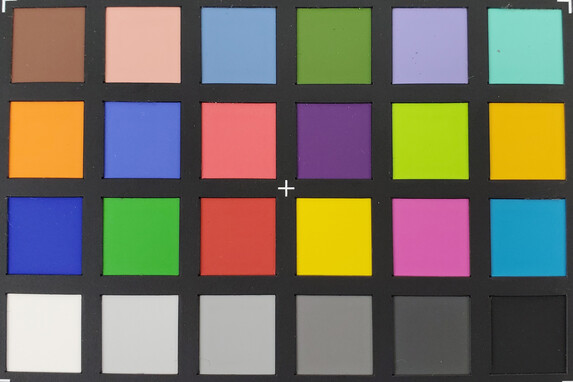
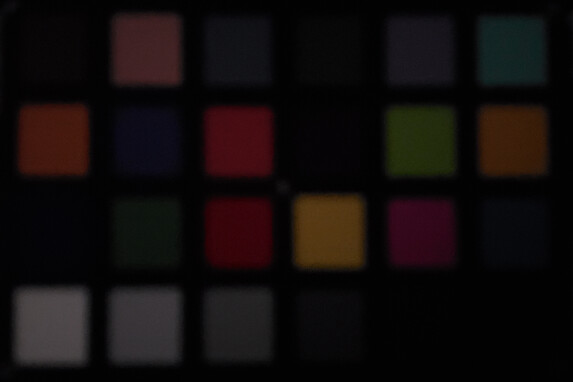
Accessories & Warranty - Galaxy Buds and Care+
Samsung has been rather generous with what accessories it includes in the box. Our review unit arrived with a modular power supply, USB cable, OTG adapter, SIM tool and the usual documentation that OEMs include with smartphones. Additionally, the Galaxy Fold comes with a matching fibre cover and Galaxy Buds (SM-R170), Samsung's wireless earbuds that retail for US$129.99. Samsung colour matches the accessories too, so if you buy a white Galaxy Fold, then you will find white accessories in the box. Samsung includes a black fibre cover irrespective of the model purchased, for some reason. The company also sell a leather cover, should you want some additional protection for your Galaxy Fold.
The Galaxy Fold comes with 24 months manufacturer's warranty. However, Samsung affords six months for the accessories that it includes in the box and 12 for the battery. Every Galaxy Fold purchase has a year's Samsung Care+ too, an accidental damage insurance product. You must register the device within 30 days to activate this, and it covers your Galaxy Fold against damage to its display, back, liquid damage and any other physical damage that prevents it from being used. You must pay a 130-Euro (~$142) deductible for each claim, though.
Please see our Guarantees, Return Policies & Warranties FAQ for country-specific information.
Input Devices & Operation - Foldable, but also wavy
Both displays have 10-point multitouch touchscreens, while the smaller display has a glass finish on which we found it easy to perform multi-finger gestures. The display is large enough to complete most tasks in our opinion, even if the keyboard is rather small by the standard of today's smartphones. The comparatively low screen-to-body ratio bothered us most here, with it seemingly being possible for Samsung to have included a larger display instead.
Samsung covers the foldable main display with a plastic film, as we mentioned earlier. The display always retains a slight fold to it even when unfolded, which does not look great. This did not bother us in daily use though as light image content simply outshines the distortion that the folded part creates. The plastic surface offers more resistance than glass does too, which sometimes irritated us when gaming.
Magnets hold the Galaxy Fold securely together when folded. These do not accidentally open during daily use and the hinge mechanism feels clean when in-use. It is not infinitely adjustable though, in case you were wondering.
The Galaxy Fold has a fingerprint sensor too, which Samsung has integrated under the secondary display. The one in our review unit unlocks the device quickly, but then so does using the facial unlock, a pattern, password or PIN. The facial unlock takes a 2D picture of your face using the front-facing camera, so it is not as secure as 3D equivalents like Apple Face ID.
Displays - Strong with small compromises
The highlight of the Galaxy Fold is its 7.3-inch foldable display. Called a flexible Dynamic AMOLED panel, the display has a 2152x1536 resolution that is crisp enough to read a newspaper page on without having to zoom in for additional clarity.
The Galaxy Fold has a dimmer display than its Galaxy S and Galaxy Note siblings, though. Our review unit achieved an average maximum luminosity of 530 cd/m² during our tests, which is still a good value. Even if Samsung claims that the device supports HDR10+, its main display does not get bright enough to take advantage of the functionality. Even the more practical APL50 test records a maximum luminosity of 640 cd/m², making HDR10+ out of reach for the Galaxy Fold. Disabling automatic brightness results in an average peak luminosity of 331 cd/m² too. Since the panel is an OLED one, it theoretically has an absolute zero black value and an infinite contrast ratio.
Well-known features like night mode and an always-on display (AoD) are on board too. The device uses pulse-width modulation (PWM) to regulate brightness too, which can cause health issues like eyestrain and headaches for some people. The main display in our review unit flickers at between 235.8 and 240.4 Hz, for reference.
| |||||||||||||||||||||||||
Brightness Distribution: 97 %
Center on Battery: 531 cd/m²
Contrast: ∞:1 (Black: 0 cd/m²)
ΔE ColorChecker Calman: 2.3 | ∀{0.5-29.43 Ø4.83}
ΔE Greyscale Calman: 1.5 | ∀{0.09-98 Ø5.1}
99.6% sRGB (Calman 2D)
Gamma: 2.15
CCT: 6631 K
| Samsung Galaxy Fold Infinity Flex-Display (Dynamic AMOLED, 7,3") und Super AMOLED (4,6"), 2152x1536, 7.3" | Samsung Galaxy S10 5G OLED, 3040x1440, 6.7" | Samsung Galaxy Note10+ Dynamic AMOLED, 3040x1440, 6.8" | Apple iPhone 11 Pro Max OLED, 2688x1242, 6.5" | Huawei Mate 20 X OLED, 2244x1080, 7.2" | ZTE Axon 10 Pro AMOLED, 2340x1080, 6.5" | |
|---|---|---|---|---|---|---|
| Screen | -31% | -8% | 20% | 10% | -59% | |
| Brightness middle | 531 | 735 38% | 683 29% | 790 49% | 421 -21% | 402 -24% |
| Brightness | 532 | 735 38% | 694 30% | 790 48% | 418 -21% | 399 -25% |
| Brightness Distribution | 97 | 94 -3% | 96 -1% | 97 0% | 96 -1% | 92 -5% |
| Black Level * | ||||||
| Colorchecker dE 2000 * | 2.3 | 3.9 -70% | 2.9 -26% | 1.4 39% | 1.1 52% | 4.1 -78% |
| Colorchecker dE 2000 max. * | 3.7 | 10.9 -195% | 4.8 -30% | 3.4 8% | 2.2 41% | 6.5 -76% |
| Greyscale dE 2000 * | 1.5 | 1.4 7% | 2.2 -47% | 1.9 -27% | 1.4 7% | 3.7 -147% |
| Gamma | 2.15 102% | 2.09 105% | 2.11 104% | 2.23 99% | 2.23 99% | 2.23 99% |
| CCT | 6631 98% | 6549 99% | 6247 104% | 6466 101% | 6723 97% | 7841 83% |
* ... smaller is better
Screen Flickering / PWM (Pulse-Width Modulation)
| Screen flickering / PWM detected | 240.4 Hz | ≤ 99 % brightness setting | |
The display backlight flickers at 240.4 Hz (worst case, e.g., utilizing PWM) Flickering detected at a brightness setting of 99 % and below. There should be no flickering or PWM above this brightness setting. The frequency of 240.4 Hz is relatively low, so sensitive users will likely notice flickering and experience eyestrain at the stated brightness setting and below. In comparison: 53 % of all tested devices do not use PWM to dim the display. If PWM was detected, an average of 8327 (minimum: 5 - maximum: 343500) Hz was measured. | |||
The foldable display is colour accurate too, but the white point is a bit too warm for our liking on the default natural display profile. It still looks natural, though. We should also point out that only the vivid mode uses the wider DCI P3 colour space, with Samsung having based the natural on sRGB, instead.
Display Response Times
| ↔ Response Time Black to White | ||
|---|---|---|
| 5.6 ms ... rise ↗ and fall ↘ combined | ↗ 2.8 ms rise | |
| ↘ 2.8 ms fall | ||
| The screen shows very fast response rates in our tests and should be very well suited for fast-paced gaming. In comparison, all tested devices range from 0.1 (minimum) to 240 (maximum) ms. » 16 % of all devices are better. This means that the measured response time is better than the average of all tested devices (20.5 ms). | ||
| ↔ Response Time 50% Grey to 80% Grey | ||
| 8.4 ms ... rise ↗ and fall ↘ combined | ↗ 4 ms rise | |
| ↘ 4.4 ms fall | ||
| The screen shows fast response rates in our tests and should be suited for gaming. In comparison, all tested devices range from 0.165 (minimum) to 636 (maximum) ms. » 20 % of all devices are better. This means that the measured response time is better than the average of all tested devices (32.1 ms). | ||
Exterior display - smaller, but also brighter
The secondary display is a 4.7-inch Super AMOLED panel that resolves at 1680x720. While it is only a 720p panel, its small footprint allows content to still look crisp. The smaller display is noticeably brighter than the main one too while offering comparable colour accuracy. Samsung limits the display to being used in vertical mode, though.
The secondary display uses PWM too, with the one in our review unit flickering at between 225.8 and 245.1 Hz when set to below 100% brightness. Incidentally, setting the display to peak luminosity causes the PWM frequency to drop to 60 Hz.
Again, all well-known features of Samsung smartphones like night mode, AoD and colour profiles are available on the smaller display. All apply to both panels simultaneously though. Hence, one cannot be in day mode and the other in night mode, for example.
The display has excellent colour reproduction too, along with the same black and contrast benefits that the main display has, thanks to it also being an OLED panel. The secondary display reached almost 700 cd/m² according to X-Rite i1Pro 2 and 867 cd/m² in APL50, making it significantly brighter than the main panel. It can also be dimmed to just 1.69 cd/m² but is limited to 330 cd/m² with the ambient light sensor disabled.
Performance - Bringing the Snapdragon 855 into the Fold
Samsung equips the Galaxy Fold with the Qualcomm Snapdragon 855, an old acquaintance that currently remains one of the faster mobile SoCs on the market. Qualcomm released a Snapdragon 855 Plus SoC too, but the two are essentially identical. Samsung complements the Snapdragon 855 with 12 GB of LPDDR4x RAM and 512 GB of UFS 3.0 flash storage, while the Adreno 640 that Qualcomm integrates within the SoC handles graphics.
Expectedly, our review unit performed comparatively strongly in synthetic benchmarks. The Galaxy Fold delivers excellent system performance in daily use too.
| PCMark for Android | |
| Work performance score (sort by value) | |
| Samsung Galaxy Fold | |
| Huawei Mate 20 X | |
| Samsung Galaxy S10 5G | |
| ZTE Axon 10 Pro | |
| Average Qualcomm Snapdragon 855 (10330 - 14439, n=19) | |
| Work 2.0 performance score (sort by value) | |
| Samsung Galaxy Fold | |
| Huawei Mate 20 X | |
| Samsung Galaxy S10 5G | |
| ZTE Axon 10 Pro | |
| Average Qualcomm Snapdragon 855 (8342 - 11440, n=19) | |
| AnTuTu v7 - Total Score (sort by value) | |
| Samsung Galaxy Fold | |
| Apple iPhone 11 Pro Max | |
| Huawei Mate 20 X | |
| Samsung Galaxy S10 5G | |
| ZTE Axon 10 Pro | |
| Average Qualcomm Snapdragon 855 (217967 - 398720, n=16) | |
| AnTuTu v6 - Total Score (sort by value) | |
| Samsung Galaxy Fold | |
| Huawei Mate 20 X | |
| Samsung Galaxy S10 5G | |
| ZTE Axon 10 Pro | |
| Average Qualcomm Snapdragon 855 (239512 - 268271, n=12) | |
The larger and correspondingly higher resolution display than its peers does not affect browser performance either. The Galaxy Fold scored highly in browser benchmarks, while the preinstalled Samsung Browser 10.1 remained fluid and fast throughout our tests.
| Jetstream 2 - 2.0 Total Score | |
| Average of class Smartphone (13.8 - 387, n=154, last 2 years) | |
| Apple iPhone 11 Pro Max (Safari Mobile 13.1) | |
| Average Qualcomm Snapdragon 855 (45.5 - 67, n=16) | |
| Samsung Galaxy Fold (Samung Browser 10.1) | |
| ZTE Axon 10 Pro (Chrome 74) | |
| Samsung Galaxy S10 5G (Samung Browser 9.2) | |
| Samsung Galaxy Note10+ (Samung Browser 9.2) | |
| JetStream 1.1 - Total Score | |
| Apple iPhone 11 Pro Max (Safari Mobile 13.1) | |
| ZTE Axon 10 Pro (Chrome 74) | |
| Samsung Galaxy Fold (Samsung Browser 10.1) | |
| Average Qualcomm Snapdragon 855 (84.4 - 120, n=17) | |
| Huawei Mate 20 X (hrome 71) | |
| Samsung Galaxy S10 5G (Samsung Browser 9.2) | |
| Samsung Galaxy Note10+ (Samsung Browser 9.2) | |
| Speedometer 2.0 - Result | |
| Average of class Smartphone (15.2 - 585, n=137, last 2 years) | |
| Apple iPhone 11 Pro Max (Safari Mobile 13.1) | |
| ZTE Axon 10 Pro (Chrome 74) | |
| Average Qualcomm Snapdragon 855 (42.5 - 67.9, n=15) | |
| Samsung Galaxy Fold (Samsung Browser 10.1) | |
| Samsung Galaxy S10 5G (Samsung Browser 9.2) | |
| Samsung Galaxy Note10+ (Samsung Browser 9.2) | |
| WebXPRT 3 - Overall | |
| Apple iPhone 11 Pro Max (Safari Mobile 13.1) | |
| Average of class Smartphone (38 - 347, n=55, last 2 years) | |
| Samsung Galaxy Fold (Samsung Browser 10.1) | |
| Samsung Galaxy Note10+ (Samsung Browser 9.2) | |
| Samsung Galaxy S10 5G | |
| Average Qualcomm Snapdragon 855 (90 - 129, n=20) | |
| ZTE Axon 10 Pro (Chrome 74) | |
| Huawei Mate 20 X (hrome 71) | |
| Octane V2 - Total Score | |
| Apple iPhone 11 Pro Max (Safari Mobile 13.1) | |
| Average of class Smartphone (2228 - 100368, n=204, last 2 years) | |
| ZTE Axon 10 Pro (Chrome 74) | |
| Samsung Galaxy Fold (Samsung Browser 10.1) | |
| Average Qualcomm Snapdragon 855 (17011 - 33918, n=21) | |
| Huawei Mate 20 X (hrome 71) | |
| Samsung Galaxy S10 5G (Samsung Browser 9.2) | |
| Samsung Galaxy Note10+ (Samsung Browser 9.2) | |
| Mozilla Kraken 1.1 - Total | |
| Samsung Galaxy Note10+ (Samsung Browser 9.2) | |
| Average Qualcomm Snapdragon 855 (1852 - 2611, n=19) | |
| Huawei Mate 20 X (hrome 71) | |
| Samsung Galaxy Fold (Samsung Browser 10.1) | |
| ZTE Axon 10 Pro (Chrome 74) | |
| Samsung Galaxy S10 5G (Samsung Browser 9.2) | |
| Average of class Smartphone (277 - 28190, n=158, last 2 years) | |
| Apple iPhone 11 Pro Max (Safari Mobile 13.1) | |
* ... smaller is better
Having 512 GB of storage almost makes up for the lack of microSD card expansion, although we should point out that Samsung does sell a 1 TB version of the Galaxy S10+. The Galaxy S10 series and Galaxy Note 10+ have microSD card readers too. Galaxy Fold owners must put up with using cloud or external storage solutions if they need more space, though.
Positively, the Galaxy Fold has fast internal storage. While it averaged 30% higher transfer speeds in AndroBench than the Galaxy S10 5G could muster, it is resoundingly beaten by the Galaxy Note 10+. The Mate 20 X and ZTE Axon 10 Pro also pull away from the Fold here.
| Samsung Galaxy Fold | Huawei Mate 20 X | Samsung Galaxy S10 5G | ZTE Axon 10 Pro | Samsung Galaxy Note10+ | OnePlus 7 Pro | Average 512 GB UFS 3.0 Flash | Average of class Smartphone | |
|---|---|---|---|---|---|---|---|---|
| AndroBench 3-5 | 124% | -30% | 108% | 131% | -2% | 142% | 343% | |
| Sequential Read 256KB | 1303 | 912 -30% | 816 -37% | 769 -41% | 1504 15% | 1468 13% | 1593 ? 22% | 2158 ? 66% |
| Sequential Write 256KB | 394.5 | 182.7 -54% | 246.3 -38% | 503 28% | 588 49% | 387 -2% | 565 ? 43% | 1749 ? 343% |
| Random Read 4KB | 158.4 | 144.4 -9% | 135 -15% | 150.4 -5% | 196.2 24% | 174.1 10% | 211 ? 33% | 294 ? 86% |
| Random Write 4KB | 34.41 | 237.6 590% | 23.79 -31% | 189.5 451% | 183.6 434% | 24.8 -28% | 196.5 ? 471% | 336 ? 876% |
Games - The Fold is a gaming monster
The Galaxy Fold has a much higher display resolution than its contemporaries, so we expected Samsung to limit performance somewhat. Thankfully that is not the case, with our review unit able to average 58.1 FPS in PUBG Mobile according to GameBench. Likewise, the device averaged 59.7 FPS while playing Battle Bay, during which it never dropped below 59 FPS. Overall, the Galaxy Fold is an excellent gaming smartphone.
PUBG Mobile
Battle Bay
Emissions - A Fold with good speakers
Temperature
The surface temperatures of the Galaxy Fold are always harmless. No area of our review unit ever exceeded 37.2 °C during our tests.
The Galaxy Fold also had no issues during the older T-Rex GFXBench battery test. However, our review unit throttled by about a third in the more complex Manhattan benchmark.
(+) The maximum temperature on the upper side is 36.6 °C / 98 F, compared to the average of 35.2 °C / 95 F, ranging from 21.9 to 247 °C for the class Smartphone.
(+) The bottom heats up to a maximum of 35.1 °C / 95 F, compared to the average of 34 °C / 93 F
(+) In idle usage, the average temperature for the upper side is 25.7 °C / 78 F, compared to the device average of 32.9 °C / 91 F.
Speakers
Samsung has equipped the Galaxy Fold with two AKG-optimised speakers that support Dolby Atmos and offer a comparatively good listening experience. As our measurements below demonstrate, frequencies between 375 and 12,000 Hz are almost linear at medium volumes. Increasing the volume to near maximum results in high-pitched tones being overrepresented, causing audio to sound a touch echoey.
Alternatively, you could connect external audio equipment via USB Type-C or Bluetooth. The latter supports dual audio for outputting to two devices simultaneously, along with all common Bluetooth audio codecs. However, Samsung continues to eschew support for aptX HD, despite the Galaxy Fold being powered by a compatible Qualcomm SoC.
Samsung Galaxy Fold audio analysis
(+) | speakers can play relatively loud (85.2 dB)
Bass 100 - 315 Hz
(-) | nearly no bass - on average 23.9% lower than median
(±) | linearity of bass is average (12.2% delta to prev. frequency)
Mids 400 - 2000 Hz
(+) | balanced mids - only 2.9% away from median
(+) | mids are linear (4.3% delta to prev. frequency)
Highs 2 - 16 kHz
(+) | balanced highs - only 2.8% away from median
(+) | highs are linear (2.7% delta to prev. frequency)
Overall 100 - 16.000 Hz
(±) | linearity of overall sound is average (16.7% difference to median)
Compared to same class
» 7% of all tested devices in this class were better, 6% similar, 87% worse
» The best had a delta of 12%, average was 36%, worst was 134%
Compared to all devices tested
» 27% of all tested devices were better, 7% similar, 66% worse
» The best had a delta of 4%, average was 24%, worst was 134%
Apple iPhone 11 Pro Max audio analysis
(+) | speakers can play relatively loud (85.8 dB)
Bass 100 - 315 Hz
(-) | nearly no bass - on average 15.4% lower than median
(±) | linearity of bass is average (10.3% delta to prev. frequency)
Mids 400 - 2000 Hz
(±) | higher mids - on average 5.7% higher than median
(+) | mids are linear (5.9% delta to prev. frequency)
Highs 2 - 16 kHz
(±) | higher highs - on average 8.8% higher than median
(+) | highs are linear (3.5% delta to prev. frequency)
Overall 100 - 16.000 Hz
(±) | linearity of overall sound is average (19.4% difference to median)
Compared to same class
» 26% of all tested devices in this class were better, 8% similar, 66% worse
» The best had a delta of 12%, average was 36%, worst was 134%
Compared to all devices tested
» 46% of all tested devices were better, 7% similar, 47% worse
» The best had a delta of 4%, average was 24%, worst was 134%
Power Management - Better runtimes with Qualcomm
Power Consumption
The Galaxy Fold has class-leading power consumption even with its comparatively large display. Our review unit consumes between 0.6 W and 1 W when idling, values that only the ZTE Axon 10 Pro gets close to matching. The Galaxy Fold also consumes between 4.47 W and 9.02 W under load, which puts it ahead of the Mate 20 X and Galaxy S10 5G, but behind our other two comparison devices. As expected, the smaller secondary display requires less power than its bigger sibling, so the Galaxy Fold should have all-round excellent battery life regardless of how you use it.
The Galaxy Fold also supports up to 15 W wired and 12 W wireless charging. The device can charge other devices too, like the bundled Galaxy Buds, thanks to Samsung's Wireless PowerShare.
| Off / Standby | |
| Idle | |
| Load |
|
Key:
min: | |
| Samsung Galaxy Fold 4235 mAh | Apple iPhone 11 Pro Max 3969 mAh | Huawei Mate 20 X 5000 mAh | Samsung Galaxy S10 5G 4500 mAh | ZTE Axon 10 Pro 4000 mAh | Average Qualcomm Snapdragon 855 | Average of class Smartphone | |
|---|---|---|---|---|---|---|---|
| Power Consumption | -88% | -50% | -51% | -10% | -43% | -50% | |
| Idle Minimum * | 0.6 | 0.92 -53% | 0.79 -32% | 0.66 -10% | 0.76 -27% | 0.939 ? -57% | 0.868 ? -45% |
| Idle Average * | 0.85 | 2.9 -241% | 1.72 -102% | 1.82 -114% | 1.15 -35% | 1.506 ? -77% | 1.426 ? -68% |
| Idle Maximum * | 1 | 2.94 -194% | 1.83 -83% | 1.83 -83% | 1.18 -18% | 1.799 ? -80% | 1.588 ? -59% |
| Load Average * | 4.47 | 3.65 18% | 5.53 -24% | 6.11 -37% | 3.95 12% | 4.61 ? -3% | 7.17 ? -60% |
| Load Maximum * | 9.02 | 6.18 31% | 9.85 -9% | 9.81 -9% | 7.49 17% | 9.04 ? -0% | 10.8 ? -20% |
* ... smaller is better
Battery Life
Although the 5G version of the Galaxy Fold has a slightly smaller battery capacity than its 4G counterpart, the former has good battery life. However, it did not last as long between charges as our power consumption comparison table above would have suggested. While the Galaxy Fold averaged significantly lower values than all but the ZTE Axon 10 Pro, the iPhone 11 Pro Max, Mate 20 X and Galaxy S10 5G all achieved longer runtimes than their foldable competitor.
While we were unable to complete a battery test running solely on 5G, we can provide an extrapolated value. Our review unit sustained an HD stream on Netflix for over seven hours, which is surprisingly good. Better still, it did so outdoors on a sunny day, so it was streaming at maximum display brightness.
| Samsung Galaxy Fold 4235 mAh | Apple iPhone 11 Pro Max 3969 mAh | Huawei Mate 20 X 5000 mAh | Samsung Galaxy S10 5G 4500 mAh | ZTE Axon 10 Pro 4000 mAh | Samsung Galaxy Note10+ 4300 mAh | OnePlus 7 Pro 4000 mAh | |
|---|---|---|---|---|---|---|---|
| Battery Runtime | 41% | 9% | 8% | -1% | -8% | -5% | |
| Reader / Idle | 1724 | 2618 52% | 1984 15% | 2340 36% | 1927 12% | 1585 -8% | 1745 1% |
| H.264 | 1027 | 1346 31% | 986 -4% | 1047 2% | 1068 4% | 934 -9% | 802 -22% |
| WiFi v1.3 | 600 | 909 52% | 786 31% | 533 -11% | 680 13% | 532 -11% | 768 28% |
| Load | 316 | 408 29% | 300 -5% | 327 3% | 217 -31% | 305 -3% | 236 -25% |
Pros
Cons
Verdict - Delicate and innovative
It is finally here, the first foldable smartphone to reach our offices and Europe. Undoubtedly, the Galaxy Fold is an innovative product, with its foldable display offering a small window into the future. Whether the design that Samsung has gone for is ideal remains a matter of taste, though. The Huawei Mate X looks great, but if its panel is as sensitive as the one in the Galaxy Fold, then we would question just how durable and practical it is.
Perhaps unsurprisingly, the main display is one of the biggest shortcomings of the Galaxy Fold. The foldable display remains vulnerable despite being reinforced, so do not expect the Galaxy Fold to be rugged nor MIL-STD or IP-certified. Even pressing too hard or tapping with fingernails can cause deep impressions on the display, which could be an issue for children or those with artificial fingernails. Samsung does not necessarily cover damage caused in this way even with Care+, which is something worth keeping in mind before you buy the Galaxy Fold. We do not even want to talk about follow-up repairs after the first year, either.
Foldable, great accessories and many superlatives. The Samsung Galaxy Fold is a strong piece of technology, but perhaps it is only for those with a sensitive touch.
The software, which has so far only been adapted to this format, also dampens the enjoyment of using the Galaxy Fold. However, the Galaxy Fold is one of the first smartphones of its kind, so we can overlook its software-based shortcomings for the time being. Overall, the Galaxy Fold is a great and well-connected smartphone. So, if you have enough money to spare and you baby your smartphones, then the Samsung Galaxy Fold may be worth considering.
Samsung Galaxy Fold
- 08/31/2022 v7 (old)
Daniel Schmidt




